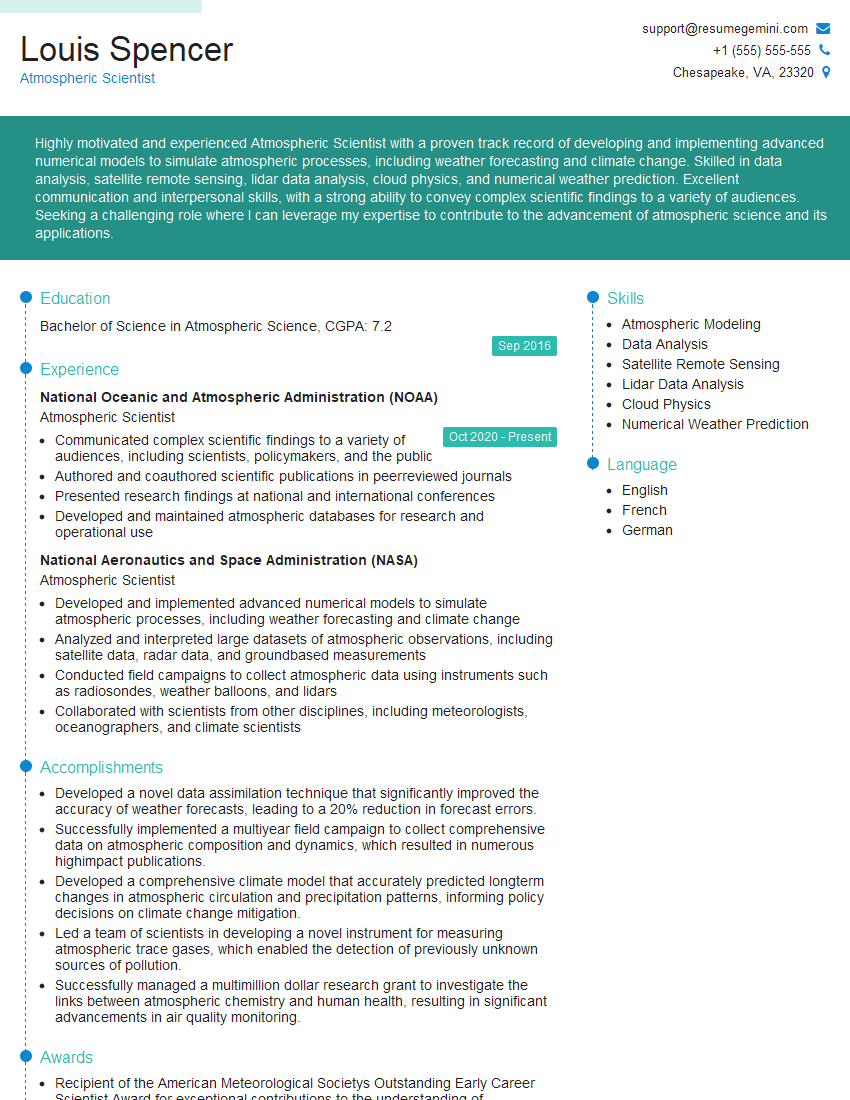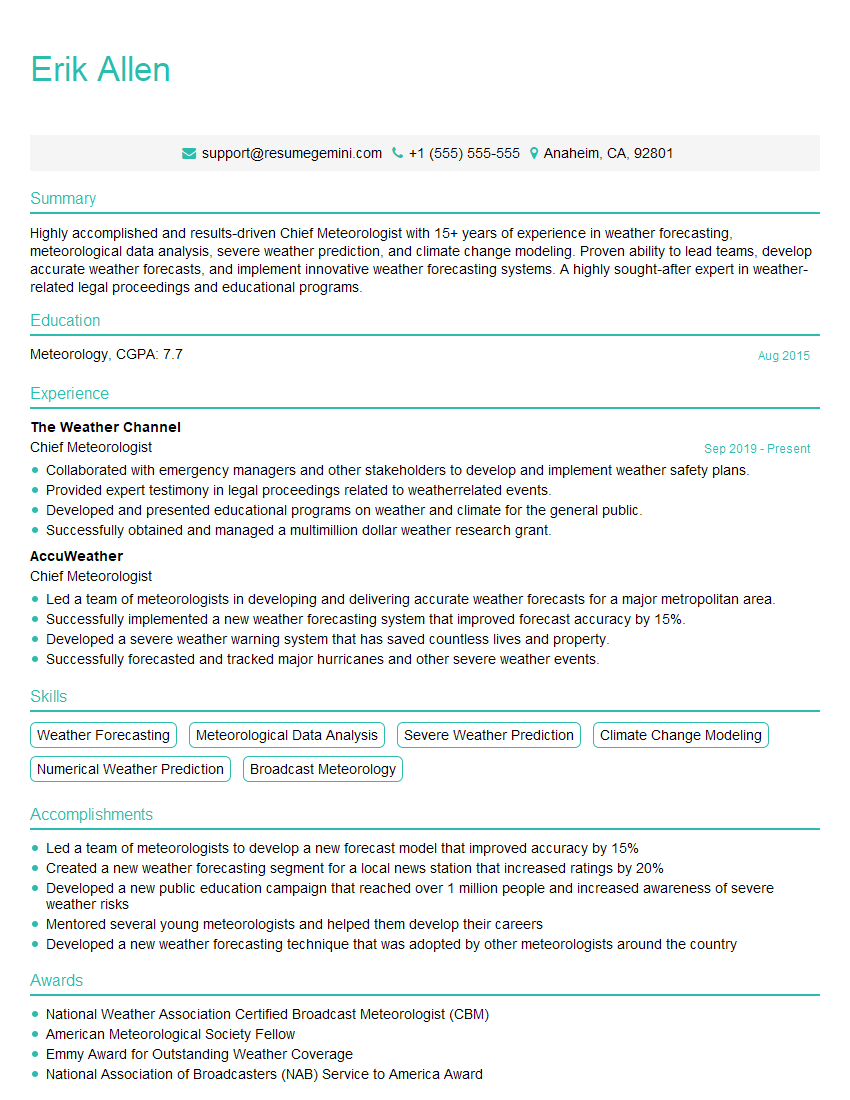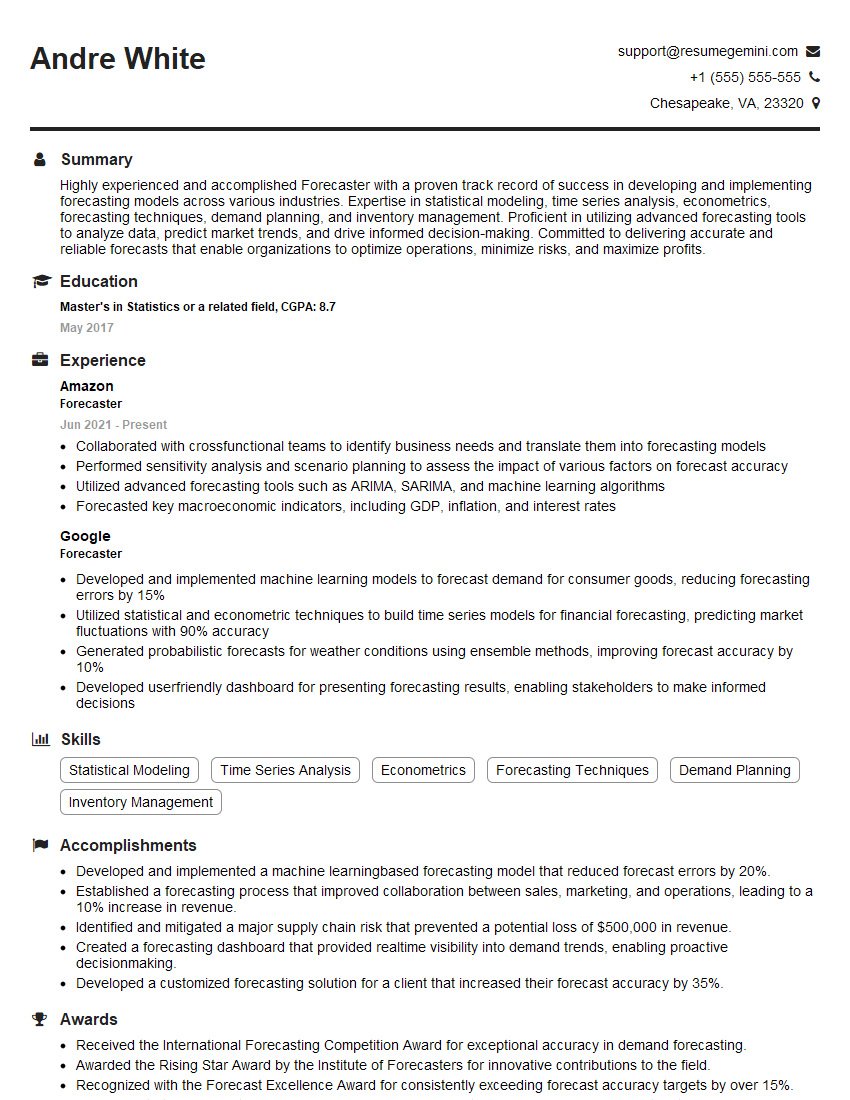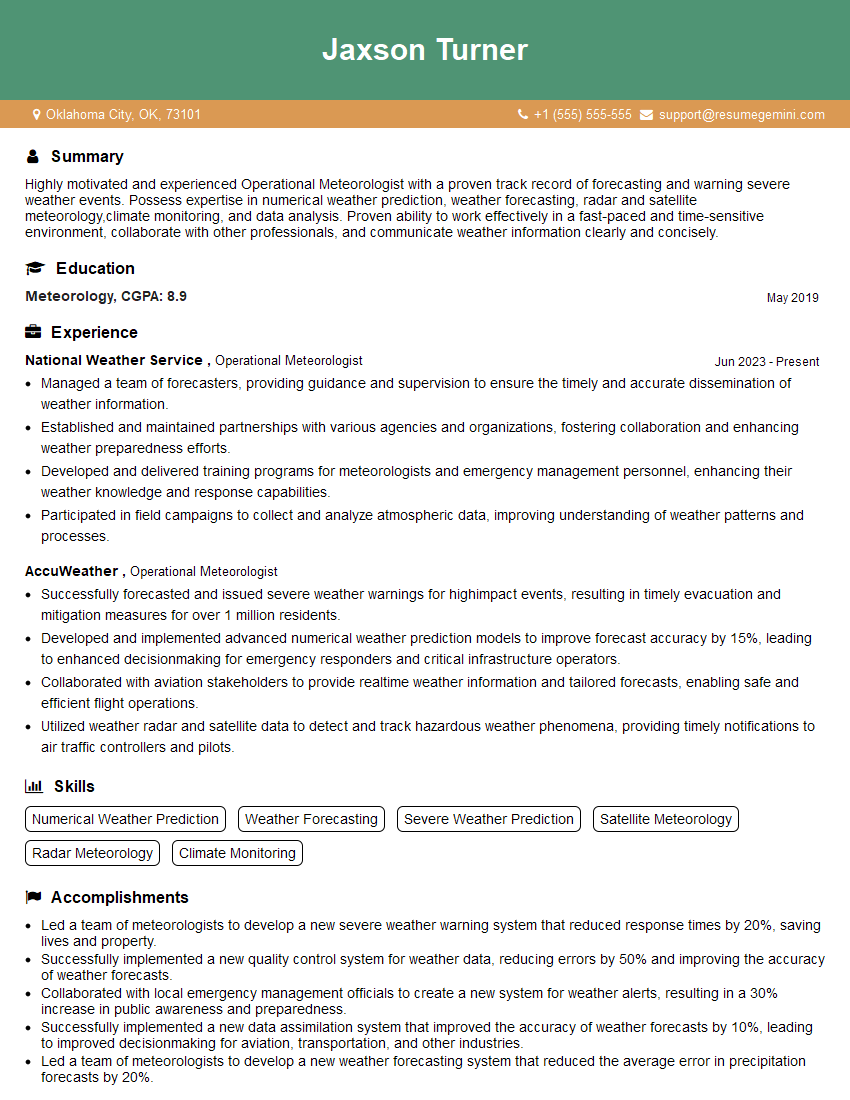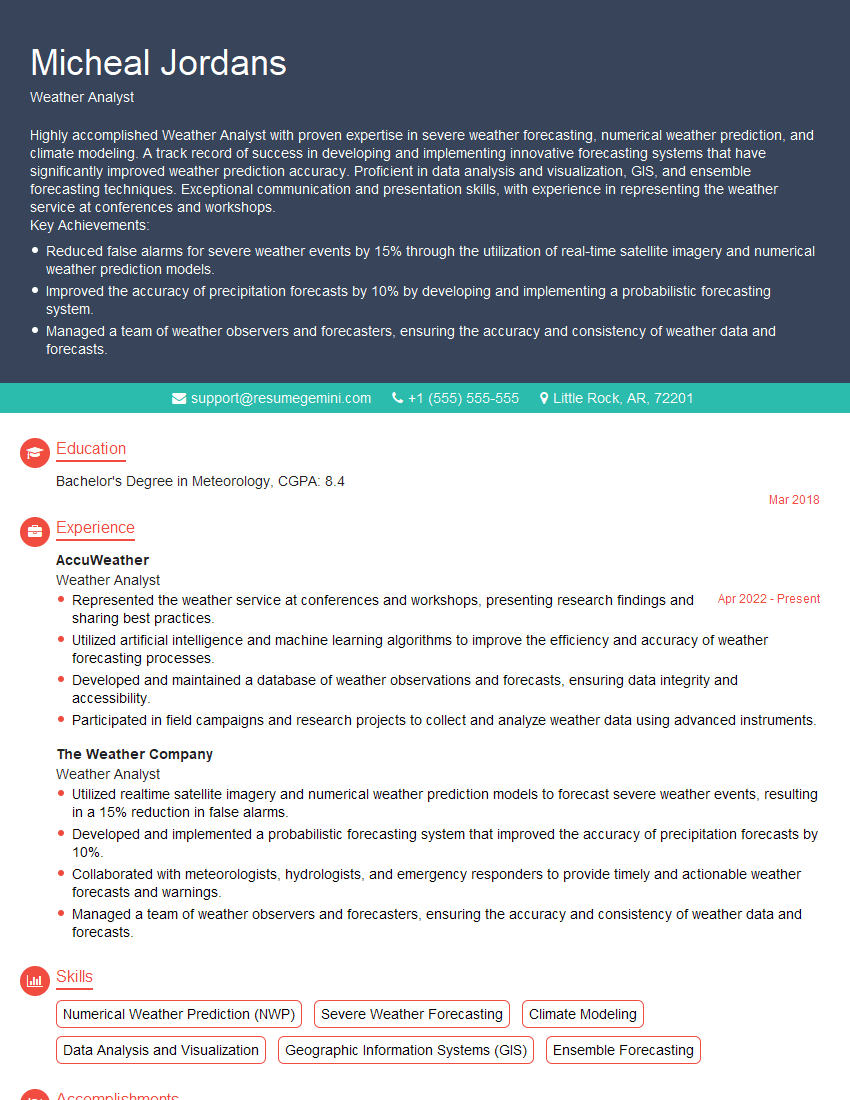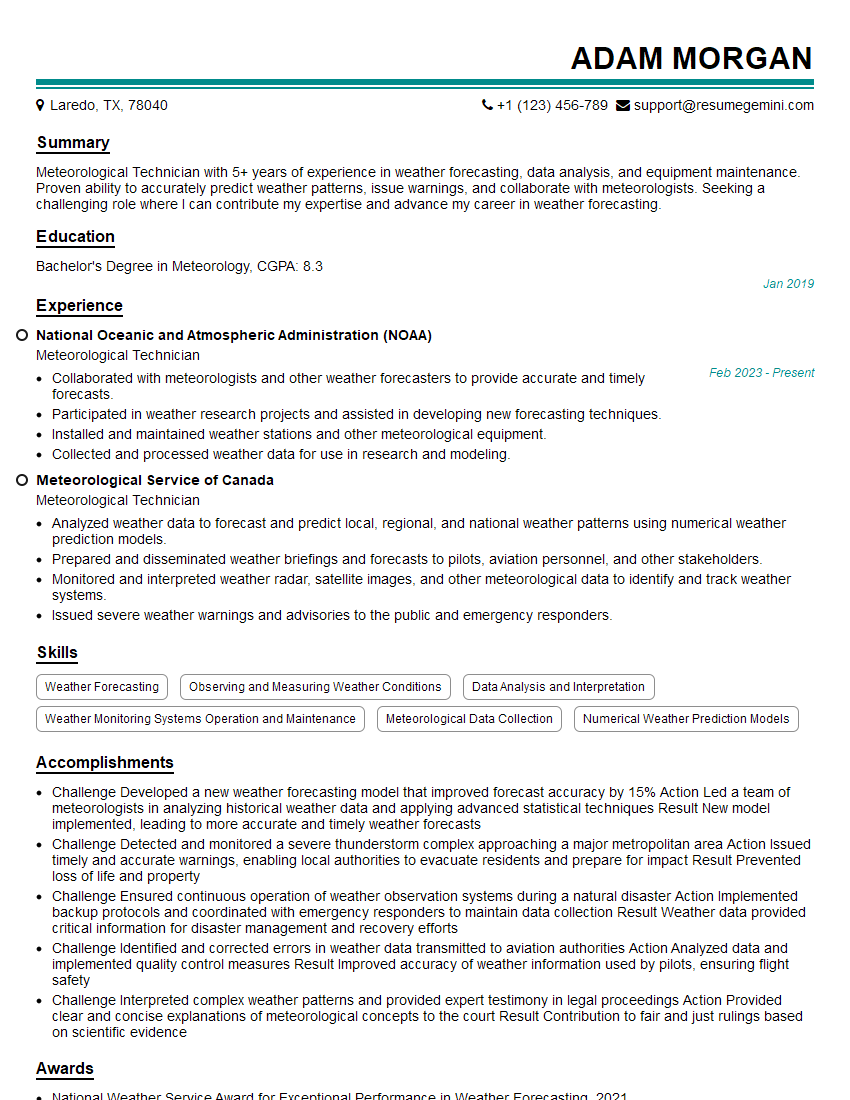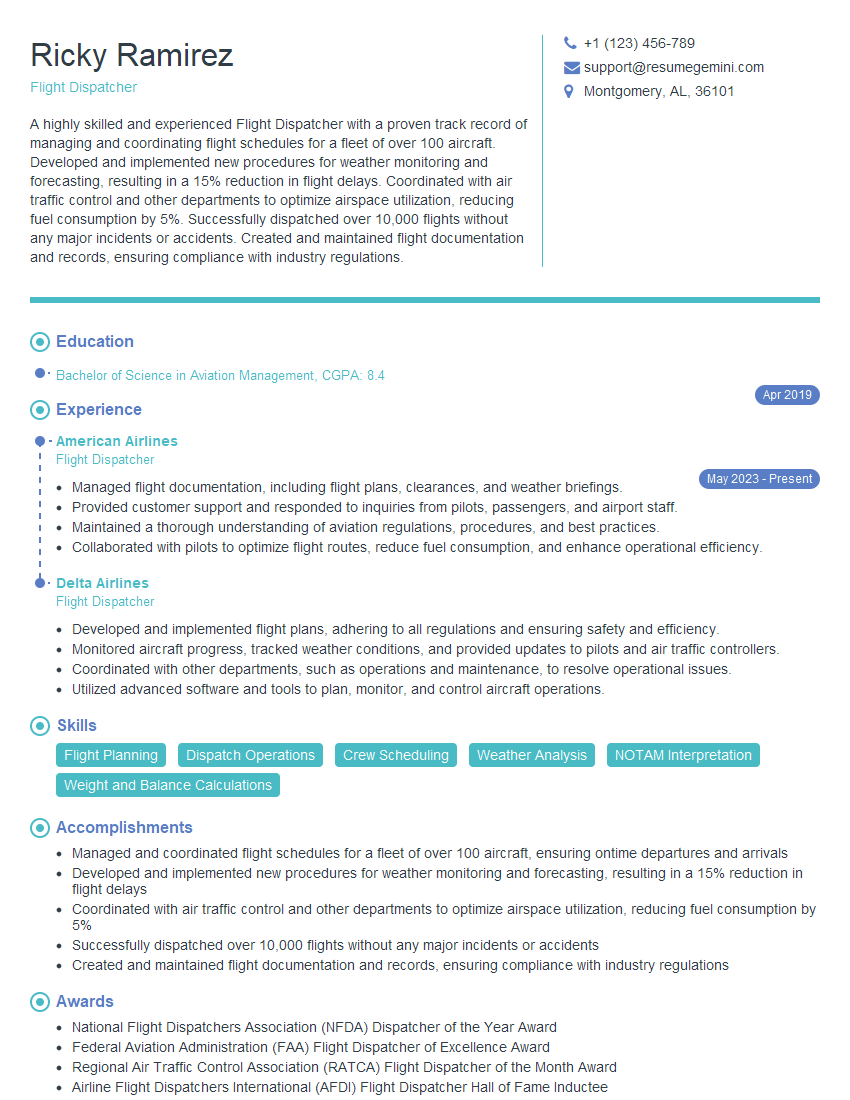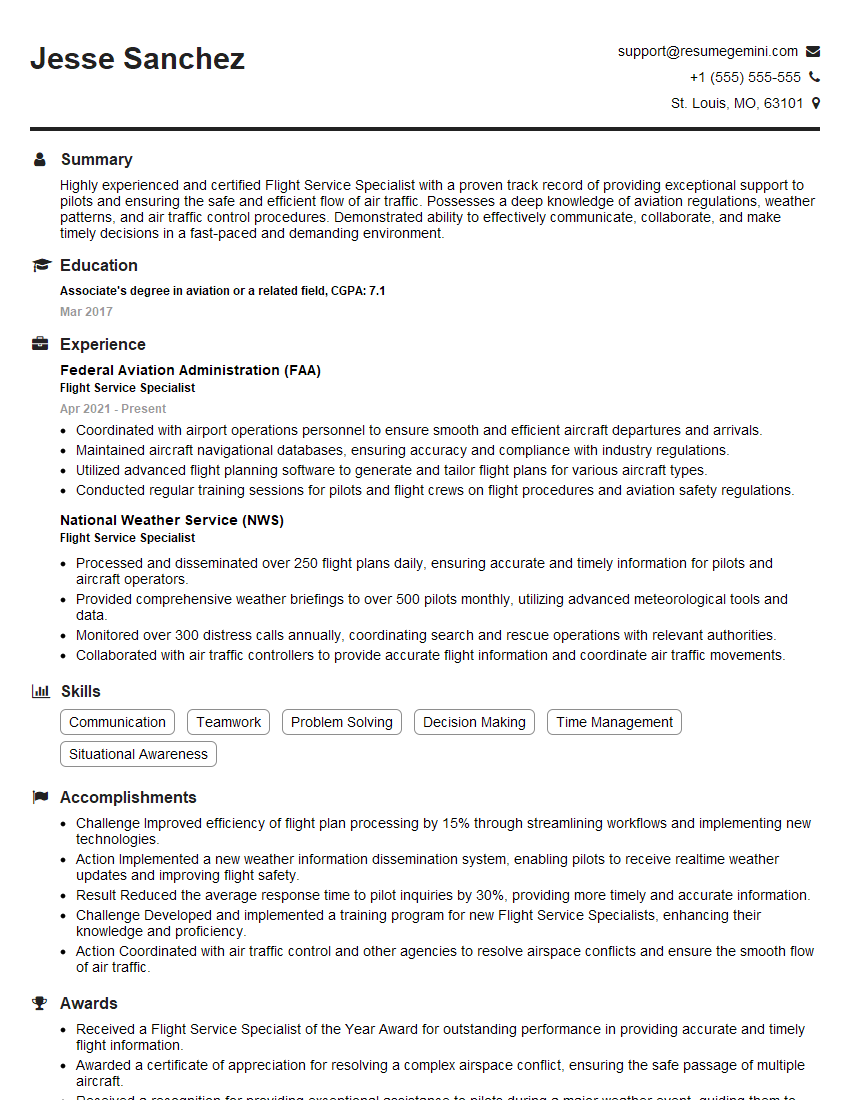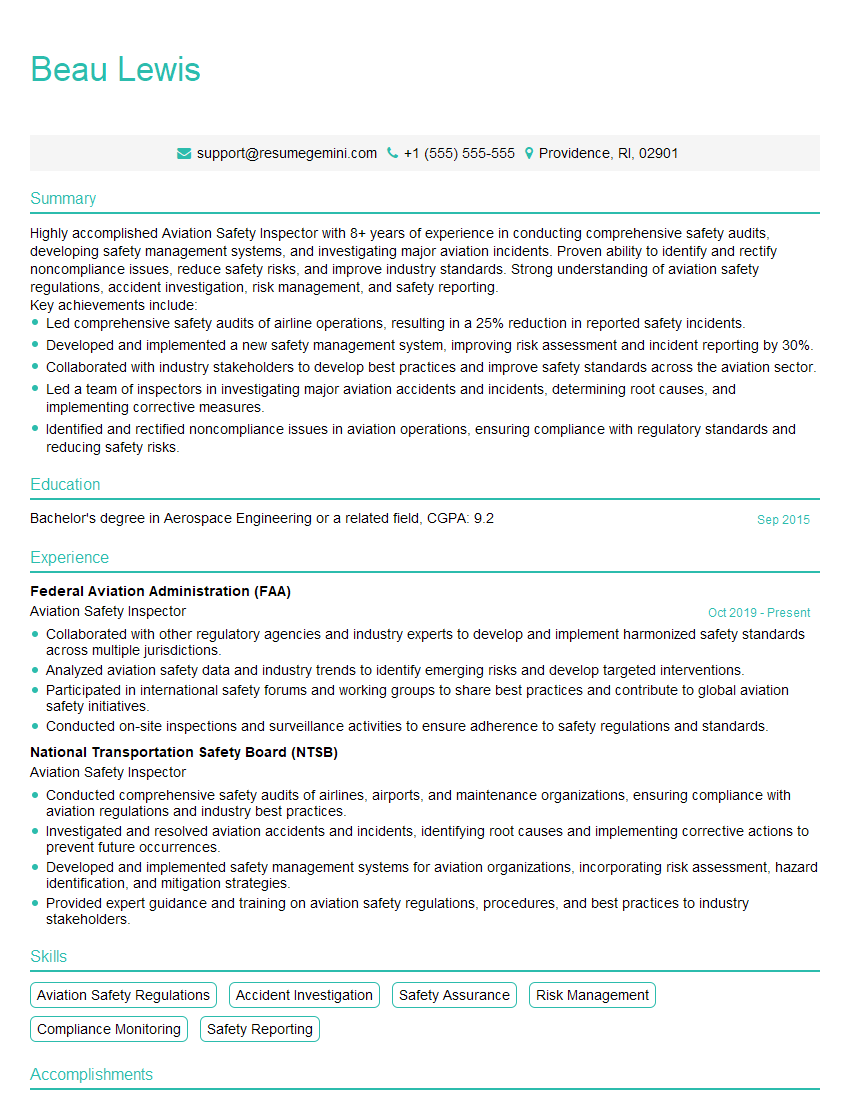The right preparation can turn an interview into an opportunity to showcase your expertise. This guide to Hazardous Weather Flight Operations interview questions is your ultimate resource, providing key insights and tips to help you ace your responses and stand out as a top candidate.
Questions Asked in Hazardous Weather Flight Operations Interview
Q 1. Explain the different types of hazardous weather affecting flight operations.
Hazardous weather significantly impacts flight safety and efficiency. Several types pose considerable threats. These include:
- Turbulence: This encompasses various forms like clear-air turbulence (CAT), convective turbulence (associated with thunderstorms), and mechanical turbulence (near mountains or terrain).
- Thunderstorms: These powerful storms bring heavy rain, hail, strong winds, lightning, and potentially dangerous microbursts (sudden, powerful downdrafts).
- Icing: Supercooled water droplets freezing on the aircraft can dramatically increase weight and disrupt airflow, impacting control and performance. This is especially dangerous in clouds or precipitation.
- Low Visibility: Fog, snow, rain, and blowing dust can severely reduce visibility, making navigation and safe landing extremely challenging.
- Wind Shear: A rapid change in wind speed or direction over a short distance can cause sudden and significant changes in aircraft attitude, leading to dangerous situations, especially during takeoff and landing.
- Strong Winds: High winds can impact aircraft handling, increasing fuel consumption and potentially making landings more difficult. Crosswinds are particularly problematic.
Understanding the characteristics and potential impact of each weather phenomenon is crucial for safe flight planning and execution.
Q 2. Describe the process of interpreting weather charts and satellite imagery.
Interpreting weather charts and satellite imagery is a cornerstone of safe flight operations. It’s a skill honed through experience and training. The process involves:
- Analyzing surface weather charts: These show current weather conditions at various locations, including temperature, pressure, wind speed and direction, precipitation, and visibility. We look for trends and patterns to predict short-term changes.
- Examining upper-air charts: These charts illustrate atmospheric conditions at various altitudes, providing insights into wind speed and direction at different flight levels, identifying potential areas of turbulence or wind shear.
- Interpreting satellite imagery: Satellite pictures provide a broad overview of cloud cover, allowing us to identify storm systems, areas of heavy precipitation, and other weather phenomena. Infrared imagery shows cloud top temperatures, which help determine storm intensity.
- Integrating data: Effective interpretation combines information from surface charts, upper-air charts, satellite imagery, and radar data to develop a comprehensive picture of the weather situation.
For example, a cluster of intense thunderstorms appearing on satellite imagery, supported by high wind speeds on upper-air charts, would warrant a thorough risk assessment and possibly a flight plan adjustment.
Q 3. How do you assess the risk associated with various weather phenomena during flight planning?
Risk assessment is a critical step in flight planning. We use a structured approach, considering:
- Severity of the weather phenomenon: How strong is the wind shear? How intense are the thunderstorms? How heavy is the icing?
- Probability of encountering the weather: How likely is the aircraft to fly through a thunderstorm or area of turbulence?
- Aircraft capabilities: Is the aircraft equipped to handle the anticipated conditions? (e.g., de-icing capabilities, flight controls robust enough for turbulence)
- Pilot experience and training: Are the pilots adequately trained to handle challenging conditions?
- Consequences of encountering the weather: What are the potential impacts? (e.g., delays, diversions, aircraft damage, passenger safety)
By carefully weighing these factors, we develop a risk profile for the flight, determining whether to proceed as planned, adjust the route, or delay the flight entirely. A flight into a known area of severe turbulence might be deemed too risky, even if the aircraft is capable, if less risky alternatives exist.
Q 4. What are the key elements of a comprehensive pre-flight weather briefing?
A comprehensive pre-flight weather briefing is essential and includes:
- Current weather conditions at departure, destination, and en route: This includes temperature, pressure, wind, visibility, cloud cover, precipitation, and any significant weather phenomena.
- Forecasted weather conditions: The briefing should provide a forecast for the entire duration of the flight, highlighting potential changes in weather conditions.
- Significant weather phenomena warnings and advisories: Details on any significant weather events (e.g., thunderstorms, icing, turbulence) and their potential impact are crucial.
- Significant weather charts and satellite imagery: Visual aids for easy understanding and situational awareness.
- Alternative routes and airports: Identification of alternate routes or airports in case weather conditions deteriorate unexpectedly.
The briefing should be tailored to the specific route and aircraft capabilities and should be delivered in a clear and concise manner, ensuring the flight crew fully understands the weather conditions and risks involved.
Q 5. Explain the significance of wind shear and its impact on aircraft.
Wind shear is a rapid change in wind speed or direction over a short distance. It’s a significant hazard, especially during takeoff and landing. The sudden changes in airflow can:
- Reduce lift: A headwind suddenly becoming a tailwind can significantly reduce the aircraft’s lift, causing a loss of altitude.
- Increase drag: A sudden increase in wind speed can dramatically increase drag, making it difficult to maintain airspeed.
- Cause aircraft to yaw or roll: Changes in wind direction can cause the aircraft to yaw (rotate about its vertical axis) or roll (rotate about its longitudinal axis), compromising control.
Microbursts, a particularly dangerous type of wind shear associated with thunderstorms, are characterized by intense downdrafts that can rapidly accelerate towards the ground. They can cause sudden and dramatic decreases in airspeed and lift, leading to accidents. Modern aircraft are equipped with wind shear detection systems, but vigilance and thorough weather planning remain essential.
Q 6. How do you handle unexpected weather changes during a flight?
Handling unexpected weather changes requires swift action and sound judgment. The process involves:
- Rapid assessment of the situation: Utilize onboard weather radar, pilot reports (PIREPs), and other available information to quickly assess the severity and extent of the unexpected change.
- Communication with air traffic control (ATC): Immediately inform ATC of the situation and request any necessary assistance or instructions (e.g., rerouting, priority landing).
- Implementing appropriate evasive maneuvers: Based on the type and severity of the weather, the pilot will execute appropriate maneuvers to avoid or minimize the impact (e.g., climbing above a layer of turbulence, diverting around a thunderstorm).
- Prioritizing safety: Safety is paramount. If the weather conditions become too dangerous, the pilot will take immediate action to ensure the safety of the aircraft and passengers, even if that means diverting to an alternate airport.
For instance, encountering unexpected turbulence, a pilot might initially adjust altitude to try and minimize the impact, before deciding to divert if conditions persist or worsen significantly.
Q 7. What are the legal requirements regarding weather reporting and documentation?
Legal requirements regarding weather reporting and documentation vary by country and regulatory authority but generally encompass:
- Pre-flight weather briefing documentation: Pilots must document the weather briefing they received before each flight, including the source of the briefing and key weather information.
- In-flight weather observations: Pilots are required to report significant weather phenomena encountered during flight, such as severe turbulence, icing, or thunderstorms. These reports (PIREPs) are crucial for updating weather forecasts and enhancing aviation safety.
- Post-flight weather reports: Depending on the specific circumstances, post-flight weather reports might be required, especially after encountering hazardous weather or an incident.
- Compliance with weather minimums: Pilots must comply with specified weather minimums for departure, approach, and landing at each airport. These minimums are determined by the type of aircraft and the airport’s facilities. Flying below these minimums is typically illegal and unsafe.
Failure to comply with these regulations can result in penalties, including fines or suspension of flight privileges. Meticulous documentation and adherence to regulations are crucial for maintaining a safe and legally compliant operation.
Q 8. Describe your experience with different weather forecasting models.
My experience encompasses a wide range of weather forecasting models, from global models like the Global Forecast System (GFS) and the European Centre for Medium-Range Weather Forecasts (ECMWF) to higher-resolution regional models such as the Rapid Refresh (RAP) and the High-Resolution Rapid Refresh (HRRR). I’m proficient in interpreting their output, understanding their strengths and limitations, and blending their data for a comprehensive weather picture. For example, while the GFS provides excellent large-scale patterns, the HRRR offers superior detail on convective activity crucial for hazardous weather flight planning. I’m also familiar with ensemble forecasting, which provides a range of possible outcomes, allowing for a more robust risk assessment. My experience includes using these models not only for general weather briefings but also for specific scenarios like mountain wave forecasting, using terrain-following models to anticipate dangerous conditions.
Q 9. Explain the concept of convective SIGMETs and AIRMETs.
Convective SIGMETs (Significant Meteorological Information) and AIRMETs (Airmen’s Meteorological Information) are warnings issued by meteorological services to alert pilots to significant weather phenomena. The key difference lies in their severity and scope. SIGMETs warn of severe and potentially hazardous weather conditions, such as widespread thunderstorms, severe turbulence, or widespread dust storms that are expected to affect a wide area for at least six hours. They are used for situations posing a significant threat to flight safety. AIRMETs, on the other hand, provide information on less severe weather, including moderate icing, moderate turbulence, sustained winds, or extensive mountain obscurations. They alert pilots to conditions that may impact flight operations but may not pose an immediate threat to safety. Think of SIGMETs as a ‘red flag’ warning, whereas AIRMETs act more like a ‘yellow flag’ caution.
For example, a convective SIGMET might warn of embedded thunderstorms producing hail and extreme turbulence over a large region, while an AIRMET might alert pilots to moderate icing conditions in a specific area along a flight path. Both are crucial for safe flight planning and execution.
Q 10. How do you communicate weather information effectively to pilots?
Effective communication with pilots is paramount. My approach involves a multi-faceted strategy. I start with a clear and concise briefing, tailored to the specific flight route and duration. I use plain language, avoiding technical jargon whenever possible. If technical terms are necessary, I always explain them clearly. I present the information logically, moving from broader regional conditions to the specific impacts on the flight plan. Visual aids, such as weather charts and satellite imagery, are invaluable in conveying complex information quickly and intuitively. I encourage two-way communication, answering pilots’ questions thoroughly and ensuring they understand the weather information. I emphasize the most critical aspects, such as the timing and location of hazardous conditions, and their potential impact on aircraft performance. Finally, I document the briefing thoroughly, including any specific instructions or advice given.
For example, if a pilot is concerned about icing conditions, I would not only provide the predicted intensity and location of icing but also discuss avoidance strategies, appropriate aircraft de-icing procedures, and potential flight plan alterations to minimize risk.
Q 11. What are the limitations of current weather forecasting technology?
Current weather forecasting technology, while remarkably advanced, still faces limitations. One key challenge is accurately predicting convective weather phenomena. Thunderstorms, for example, are highly localized and unpredictable, making accurate short-term forecasting difficult. Another limitation is the resolution of weather models. While resolution has improved dramatically, smaller-scale weather events can still be missed or misrepresented. The complexities of atmospheric interactions and the influence of terrain also pose significant challenges. Furthermore, uncertainties inherent in the initial conditions provided to the models – small variations in the starting data can lead to significantly different forecasts – introduce a margin of error. Data sparsity in certain regions, particularly over oceans or remote areas, also contributes to the forecasting uncertainties. Finally, the accurate forecasting of icing, particularly in supercooled large droplet (SLD) situations, remains a challenge.
Q 12. Describe your experience with different types of icing and their impact on flight.
My experience with aircraft icing encompasses various types, each posing different risks. Clear ice forms when supercooled water droplets freeze slowly on impact, creating a smooth, glassy layer. This type is particularly dangerous as it adheres strongly to the aircraft and significantly increases weight and drag. Rime ice, on the other hand, forms when small, supercooled droplets freeze rapidly, creating a rough, porous deposit. While it is lighter than clear ice, it can significantly disrupt airflow and airflow control surfaces. Mixed ice is a combination of clear and rime ice and represents the most complex and potentially hazardous icing scenario. The impact on flight depends on the type, intensity, and location of the ice accretion. Severe ice accumulation can lead to reduced lift, increased drag, and the malfunction of flight control surfaces, resulting in loss of control. My experience includes analyzing meteorological data to identify icing conditions, advising pilots on avoidance strategies, and evaluating de-icing and anti-icing procedures’ effectiveness.
Q 13. How do you determine the appropriate action to take based on weather conditions?
Determining the appropriate action based on weather conditions involves a systematic approach. I begin by carefully analyzing all available weather data, including forecasts, observations, and warnings. I assess the severity and likelihood of hazardous weather events along the planned flight path. Next, I evaluate the aircraft’s capabilities and limitations in various weather conditions, considering the aircraft type, its certification, and the pilot’s experience. I then weigh the risks and benefits of different options, such as flight delays, route changes, or flight cancellations. My decisions prioritize safety and always adhere to regulations and company procedures. Ultimately, the best course of action depends on the specific circumstances and often involves collaborative decision-making with pilots and flight dispatchers.
For example, if a flight encounters unexpected turbulence, I might advise the pilot to descend to a lower altitude, where turbulence is typically less severe, or divert to a nearby airport. Similarly, if severe icing is anticipated, I would work with flight dispatch to determine if a delay, route alteration, or cancellation is necessary.
Q 14. Explain your understanding of turbulence and its various causes.
Turbulence is a chaotic motion of air that can significantly affect aircraft stability and passenger comfort. Several factors can cause turbulence, including: mechanical turbulence, created by wind shear near the ground, convective turbulence caused by rising and sinking air associated with thunderstorms and thermal activity, clear-air turbulence (CAT) resulting from jet stream interactions and atmospheric instability, and mountain wave turbulence, formed when air is forced over mountain ranges, creating waves that can cause severe turbulence. Understanding these different causes is critical for anticipating and mitigating the risks associated with turbulence. For example, severe CAT can occur in seemingly clear skies far from any visible weather systems, making it particularly hazardous. Predicting and avoiding CAT requires advanced forecasting techniques and careful analysis of upper-air wind patterns. Similarly, mountain wave turbulence can be extremely intense and needs specific forecasting tools and an understanding of the terrain to identify likely areas.
Q 15. What are your strategies for mitigating weather-related risks?
Mitigating weather-related risks in hazardous weather flight operations requires a multi-layered approach focusing on proactive planning, real-time monitoring, and decisive action. It’s not just about avoiding flights; it’s about understanding the risks and making informed decisions to minimize exposure.
- Pre-flight Planning: This involves meticulously reviewing weather forecasts from multiple sources, considering the aircraft’s capabilities, and planning alternate routes or delaying the flight if necessary. We use tools like weather briefing software to visualize potential hazards, including convective activity, icing, turbulence, and low visibility.
- Real-time Monitoring: During the flight, continuous monitoring of weather radar, satellite imagery, and pilot reports is critical. This allows for dynamic adjustments to flight plans, such as rerouting to avoid severe weather or descending to avoid turbulence.
- Communication: Clear and concise communication with air traffic control, meteorological services, and the flight crew is crucial for ensuring everyone is aware of the developing situation and any necessary actions. This also includes accurately communicating potential weather-related delays or diversions to passengers.
- Decision-Making: The ability to make timely and informed decisions is paramount. This involves weighing the risks associated with continuing the flight versus the potential consequences of a delay or diversion. Safety is always the top priority.
For example, during a flight approaching a predicted thunderstorm line, we might choose to divert around the line, climb above it, or delay the arrival until the line passes. The choice depends on the intensity of the thunderstorm, the aircraft’s capabilities, and the overall risk assessment.
Career Expert Tips:
- Ace those interviews! Prepare effectively by reviewing the Top 50 Most Common Interview Questions on ResumeGemini.
- Navigate your job search with confidence! Explore a wide range of Career Tips on ResumeGemini. Learn about common challenges and recommendations to overcome them.
- Craft the perfect resume! Master the Art of Resume Writing with ResumeGemini’s guide. Showcase your unique qualifications and achievements effectively.
- Don’t miss out on holiday savings! Build your dream resume with ResumeGemini’s ATS optimized templates.
Q 16. Describe your experience with using weather radar and other meteorological instruments.
My experience with weather radar and meteorological instruments is extensive. I’m proficient in interpreting data from various sources, including NEXRAD (Next Generation Weather Radar), satellite imagery (geostationary and polar-orbiting), and atmospheric sounding data.
Weather radar provides real-time information about precipitation type, intensity, and location, allowing us to identify dangerous weather phenomena like hailstorms, microbursts, and tornadoes. I’m skilled in recognizing radar signatures associated with these hazardous weather events. Satellite imagery gives a broader perspective, providing context and information about cloud cover, temperature patterns, and the overall weather system. Atmospheric sounding data, obtained from weather balloons, offers valuable vertical profiles of temperature, humidity, and wind speed, crucial for understanding atmospheric stability and the potential for severe weather.
Beyond the visual interpretation of data, I’m adept at using specialized aviation weather software which integrates these various data sources, providing a comprehensive picture of the weather environment. This helps in making accurate forecasts, assessing risks and supporting critical decision-making. For example, I can use radar data to determine the speed and direction of a thunderstorm line and utilize this information to plan a safe route around or through the system depending on intensity and aircraft capabilities.
Q 17. How do you stay up-to-date with the latest advancements in aviation meteorology?
Staying current with advancements in aviation meteorology is crucial for maintaining my expertise. I achieve this through multiple avenues:
- Professional Organizations: Active membership in organizations like the American Meteorological Society (AMS) provides access to publications, conferences, and networking opportunities with leading experts.
- Conferences and Workshops: Attending conferences and workshops focusing on aviation meteorology allows me to learn about the latest research, technologies, and best practices.
- Publications and Journals: I regularly read peer-reviewed journals and industry publications to stay informed about the latest findings and advancements in forecasting models and techniques.
- Online Resources and Training: Numerous online courses and resources, including those provided by aviation weather service providers, offer valuable training and updates on new technologies and procedures.
- Collaboration: Regular interaction and collaboration with colleagues in the field facilitates the sharing of knowledge and experiences.
For instance, I recently completed a course on the application of new machine learning techniques in severe weather prediction which directly improves my ability to assess and interpret forecast information.
Q 18. What is your experience with using different weather data sources and databases?
I have extensive experience using a wide range of weather data sources and databases. These include:
- National Weather Service (NWS) data: I routinely access data from the NWS, including NEXRAD radar, surface observations, upper-air soundings, and forecast products.
- Commercial weather providers: I utilize data and forecasts from commercial providers like to augment NWS information and obtain specialized aviation forecasts.
- Global weather models: I have experience interpreting data from global weather models (like the Global Forecast System – GFS) to understand large-scale weather patterns and their impact on regional weather.
- Aviation-specific databases: I am familiar with databases containing historical weather data, pilot reports (PIREPs), and other relevant aviation-specific information.
The ability to effectively utilize multiple data sources and compare their outputs allows for a more comprehensive and accurate understanding of the weather situation. For instance, comparing model forecasts from different providers can help identify areas of agreement and disagreement, allowing for a more nuanced risk assessment.
Q 19. Explain your process for evaluating weather forecasts from different providers.
Evaluating weather forecasts from different providers requires a critical and systematic approach. I don’t simply accept a forecast at face value; instead, I use a multi-step process:
- Model Comparison: I compare forecasts from multiple models (e.g., GFS, NAM, ECMWF) to identify common features and any significant differences. Areas of consensus indicate higher confidence, while discrepancies warrant further investigation.
- Data Verification: I check the forecast against current observations from surface stations, radar, and satellite imagery. This helps assess the accuracy and reliability of the forecast.
- Consideration of Model Limitations: I am aware of the inherent limitations of each weather model and interpret the forecast accordingly. Some models might excel in predicting certain weather phenomena while others might be less accurate.
- Expert Analysis: When necessary, I seek input from experienced meteorologists to gain additional insights and perspectives on complex or uncertain weather situations.
- Qualitative Assessment: Beyond numerical data, I also consider qualitative information like pilot reports (PIREPs) to gain a better understanding of the current weather conditions.
By combining quantitative and qualitative data, and considering the strengths and weaknesses of each data source, I can produce a well-informed weather assessment suitable for informing flight planning decisions. For example, if a model indicates a potential for severe turbulence, but the radar shows no significant convective activity and pilot reports are clear, I would have lower confidence in the turbulence prediction.
Q 20. How would you explain a complex weather system to a non-meteorological audience?
Explaining a complex weather system to a non-meteorological audience requires clear, concise language and relatable analogies. Let’s take a low-pressure system as an example.
Imagine a spinning top. A low-pressure system is like a giant, spinning top of air. The air in the center is rising, similar to how the top spins and rises. As this air rises, it cools and condenses, forming clouds and potentially precipitation (rain, snow). The spinning motion creates winds, which flow inwards towards the center at the surface and outwards at higher altitudes. This creates a circulation pattern, where the winds rotate around the low-pressure center in a counter-clockwise direction (in the Northern Hemisphere). The stronger the spin, the stronger the winds and potential for severe weather.
So, essentially, a low-pressure system is a rotating area of rising air, leading to cloud formation, precipitation, and winds. The strength of the system determines the intensity of the weather effects.
Q 21. Describe a situation where you had to make a critical decision based on weather information.
During a flight to a mountainous region, we received a forecast predicting significant icing conditions above 10,000 feet. The initial forecast showed only light icing, but a later update highlighted an intensified icing potential due to a developing inversion layer. This meant the aircraft would encounter conditions far exceeding its de-icing capabilities.
Initially, we weighed the option of continuing the flight with the original plan, assuming the light icing forecast. However, the updated forecast, combined with the aircraft’s limitations and a lack of nearby suitable diversion airports, prompted a critical decision.
I decided to recommend a delay to the flight until the icing conditions were predicted to lessen. This wasn’t a popular decision because of scheduling pressures, but safety was paramount. We informed the passengers and diverted the aircraft to a lower-altitude airport until the situation improved. The decision to delay prevented potential catastrophic consequences that could have resulted from severe icing, demonstrating the importance of continuously monitoring, analyzing weather updates, and making decisive action.
Q 22. How do you handle conflicting weather information from different sources?
Conflicting weather information is a common challenge in aviation. My approach involves a systematic process of verification and triangulation. I never rely on a single source. First, I cross-reference data from multiple reputable sources like the National Weather Service (NWS), aviation weather briefings, and onboard weather radar. I compare the various forecasts, paying close attention to discrepancies in timing, intensity, and location of predicted weather phenomena. If significant differences exist, I look for patterns – perhaps one source is consistently more conservative or aggressive in its predictions. This helps me build a more complete and nuanced picture. For example, if one source predicts heavy turbulence in a specific area while another shows only light turbulence, I’d investigate further using additional resources like satellite imagery or pilot reports (PIREPs) to determine the most probable scenario. Ultimately, I make informed decisions based on the preponderance of evidence, prioritizing safety above all else.
Consider a scenario where one service shows a developing thunderstorm cell, but another doesn’t. I would investigate using satellite imagery for cloud top temperature, which gives an indication of storm intensity and maturity. Further, I’d look for pilot reports from aircraft recently passing through that area. This multi-layered approach minimizes reliance on any single, potentially flawed, data point.
Q 23. What are the emergency procedures for hazardous weather encounters?
Emergency procedures during hazardous weather encounters are paramount to safety. The first step is always to prioritize the safety of the crew and passengers. This might involve immediately executing an emergency descent, diverting to a safer alternate airport, or requesting immediate assistance from air traffic control (ATC). Specific actions depend entirely on the nature of the threat. For example, encountering severe turbulence requires a controlled descent to a lower, less turbulent altitude, while encountering microburst requires immediate avoidance maneuvers. I’m also trained in emergency checklists for various scenarios, such as icing conditions or unexpected thunderstorms, and I follow these meticulously to ensure a systematic response. Communication with ATC is crucial throughout the emergency. Regular updates on the aircraft’s position and the evolving situation are essential to facilitate any necessary assistance or guidance from the ground.
Imagine encountering severe icing. The checklist would guide me to apply de-icing/anti-icing procedures, adjust engine settings, and communicate the situation to ATC immediately for potential diversion or prioritized landing. The specific steps are always informed by the type of aircraft and the severity of the weather.
Q 24. Describe your experience in risk assessment and mitigation in aviation weather.
Risk assessment and mitigation are central to my approach to aviation weather. I utilize a structured framework that considers various factors, including the forecast weather, the aircraft’s capabilities, and the flight plan. My assessment always begins with a thorough review of the weather briefing, examining the probability and severity of hazards along the planned route. Next, I assess the aircraft’s limitations – for example, its tolerance for icing, turbulence, or low visibility. Finally, I evaluate the flight plan itself, looking for opportunities to avoid potential hazards or mitigate their impact. If a significant risk is identified, I develop mitigation strategies, such as altering the flight path, adjusting the flight level, or delaying the flight. This is a continuous process, adapting as new information becomes available throughout the flight.
For instance, I once encountered a situation where a significant area of convective activity was predicted along our flight path. After analyzing the forecast and weather radar data, I determined that a slight rerouting would allow us to avoid the most intense part of the storm. This small adjustment ensured a smoother, safer flight, without significant impact on the overall flight time.
Q 25. How do you prioritize various weather hazards when making flight decisions?
Prioritizing weather hazards involves a hierarchical approach based on their potential severity and impact. Immediate threats, such as severe turbulence or a rapidly developing thunderstorm directly in the flight path, take top priority. These require immediate action to ensure safety. Next, I consider hazards with a high probability of encounter but potentially lower immediate impact, such as moderate icing or low visibility. These may require adjusting the flight plan or selecting alternative procedures. Finally, I consider potential hazards further along the route or with lower probability but still requiring monitoring. This is not a rigid ranking; the specific prioritization constantly adapts as new information comes in and the situation evolves. The overall goal is to maintain a safety margin throughout the flight.
For example, if I encounter light icing and a forecast for a developing thunderstorm cell further ahead, the thunderstorm takes higher priority, as it presents a more severe risk. The actions for the light icing might involve implementing anti-icing measures while formulating a plan to either circumvent or safely pass through the thunderstorm.
Q 26. Explain your understanding of thunderstorm development and lifecycle.
Thunderstorms are complex convective systems with a distinct lifecycle. They typically begin as cumulus clouds, fueled by rising warm, moist air. As the air rises and cools, it condenses, forming towering cumulonimbus clouds. This stage is characterized by updrafts and the development of precipitation. The mature stage involves intense updrafts and downdrafts, producing heavy rain, hail, strong winds, and lightning. Finally, the dissipating stage occurs as the downdrafts dominate, cutting off the supply of warm, moist air, leading to a gradual weakening of the storm. Understanding this lifecycle allows me to anticipate the most hazardous periods of a thunderstorm’s development and make informed decisions about avoiding or navigating through it. Features like anvil clouds, often visible on satellite imagery, indicate the storm’s maturity and potential severity.
Think of it like the stages of a fire. Cumulus clouds are like the initial embers, the mature stage is the raging fire, and dissipation is the dying embers. Each stage requires a different approach to safety.
Q 27. How do you use weather information to optimize flight routes and altitudes?
Weather information is crucial for optimizing flight routes and altitudes. By analyzing weather forecasts, radar data, and satellite imagery, I identify areas of turbulence, icing, or other hazards. I then strategize routes that avoid or minimize exposure to these hazards. Altitude selection is also critical. Higher altitudes generally offer smoother air, but might encounter colder temperatures affecting fuel efficiency and icing. Lower altitudes may offer less turbulence but could expose the aircraft to more adverse weather at the surface. The optimal route and altitude are determined by balancing these considerations while ensuring safety and efficiency. Sophisticated flight planning software helps in this process, allowing for the integration of various weather data sources and real-time adjustments based on evolving conditions.
For example, if strong headwinds are forecast at a higher altitude, a slightly lower altitude with more favorable wind conditions might be chosen to optimize fuel consumption even if it means a slightly rougher ride. Conversely, if icing is predicted below a certain altitude, I would select a higher altitude even if headwinds are stronger.
Q 28. Explain the impact of temperature and pressure on aircraft performance.
Temperature and pressure significantly impact aircraft performance. Higher temperatures decrease air density, reducing lift and engine power, necessitating longer takeoff runs and potentially reducing payload capacity. Lower temperatures increase air density, having the opposite effect. Air pressure also plays a role. Lower air pressure at higher altitudes results in less dense air, again affecting lift and engine power. These factors directly influence the aircraft’s performance parameters, such as speed, climb rate, and range. Pilots must account for these effects when planning flights and making in-flight adjustments, using tools and calculations to ensure safe and efficient operations. This is particularly critical during takeoff and landing, where these effects are most pronounced.
Imagine taking off on a hot summer day. The reduced air density would require higher speeds and a longer runway compared to a colder winter day. Understanding these relationships is critical for safe operations.
Key Topics to Learn for Hazardous Weather Flight Operations Interview
- Meteorological Fundamentals: Understanding various weather phenomena like thunderstorms, icing, turbulence, low-level wind shear, and their impact on flight operations. This includes interpreting weather charts and forecasts effectively.
- Flight Planning and Decision-Making: Applying meteorological knowledge to develop safe and efficient flight plans, considering potential hazardous weather encounters. This involves risk assessment, contingency planning, and utilizing available weather information resources.
- Aircraft Systems and Limitations: Knowing the capabilities and limitations of aircraft systems in relation to hazardous weather conditions. This includes understanding de-icing procedures, onboard weather radar interpretation, and emergency procedures.
- Regulations and Procedures: Familiarity with relevant regulations and standard operating procedures (SOPs) for operating in hazardous weather. This includes understanding reporting requirements and communication protocols.
- Weather Avoidance and Diversion Strategies: Developing strategies for avoiding or mitigating hazardous weather encounters, including route planning, alternate airport selection, and communication with Air Traffic Control.
- Problem-Solving and Critical Thinking: Demonstrating the ability to analyze complex weather situations, identify potential hazards, and develop effective solutions under pressure. This involves quick decision-making and clear communication skills.
- Advanced Meteorological Concepts: Exploring topics like convective weather systems, jet streams, frontal systems, and their impact on flight safety. A deeper understanding showcases advanced knowledge.
Next Steps
Mastering Hazardous Weather Flight Operations is crucial for career advancement in aviation, opening doors to specialized roles and increased responsibility. A strong resume is your key to unlocking these opportunities. To ensure your qualifications shine, build an ATS-friendly resume that highlights your skills and experience effectively. ResumeGemini is a trusted resource that can help you craft a professional and impactful resume tailored to the aviation industry. We provide examples of resumes specifically designed for Hazardous Weather Flight Operations professionals to guide you. Invest in your future – invest in a compelling resume today.
Explore more articles
Users Rating of Our Blogs
Share Your Experience
We value your feedback! Please rate our content and share your thoughts (optional).
What Readers Say About Our Blog
Hello,
We found issues with your domain’s email setup that may be sending your messages to spam or blocking them completely. InboxShield Mini shows you how to fix it in minutes — no tech skills required.
Scan your domain now for details: https://inboxshield-mini.com/
— Adam @ InboxShield Mini
Reply STOP to unsubscribe
Hi, are you owner of interviewgemini.com? What if I told you I could help you find extra time in your schedule, reconnect with leads you didn’t even realize you missed, and bring in more “I want to work with you” conversations, without increasing your ad spend or hiring a full-time employee?
All with a flexible, budget-friendly service that could easily pay for itself. Sounds good?
Would it be nice to jump on a quick 10-minute call so I can show you exactly how we make this work?
Best,
Hapei
Marketing Director
Hey, I know you’re the owner of interviewgemini.com. I’ll be quick.
Fundraising for your business is tough and time-consuming. We make it easier by guaranteeing two private investor meetings each month, for six months. No demos, no pitch events – just direct introductions to active investors matched to your startup.
If youR17;re raising, this could help you build real momentum. Want me to send more info?
Hi, I represent an SEO company that specialises in getting you AI citations and higher rankings on Google. I’d like to offer you a 100% free SEO audit for your website. Would you be interested?
Hi, I represent an SEO company that specialises in getting you AI citations and higher rankings on Google. I’d like to offer you a 100% free SEO audit for your website. Would you be interested?
good
